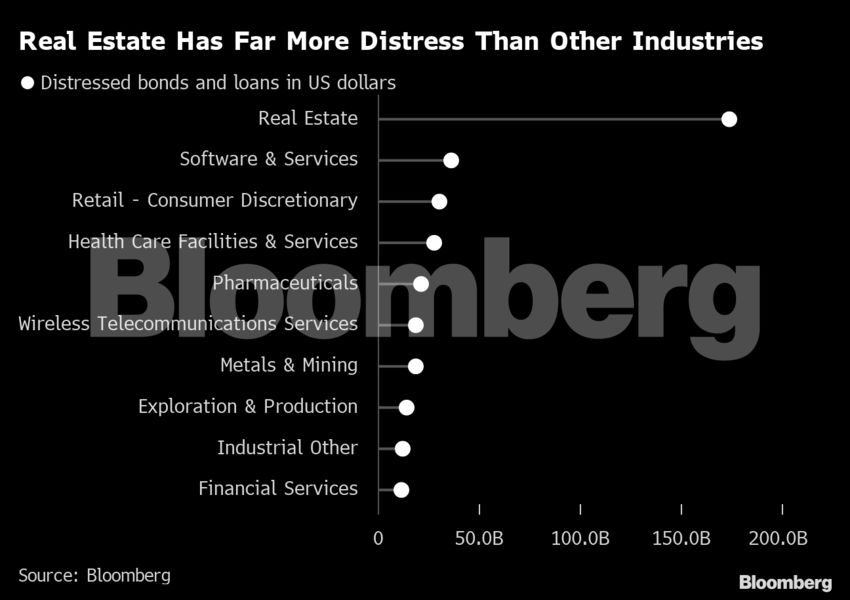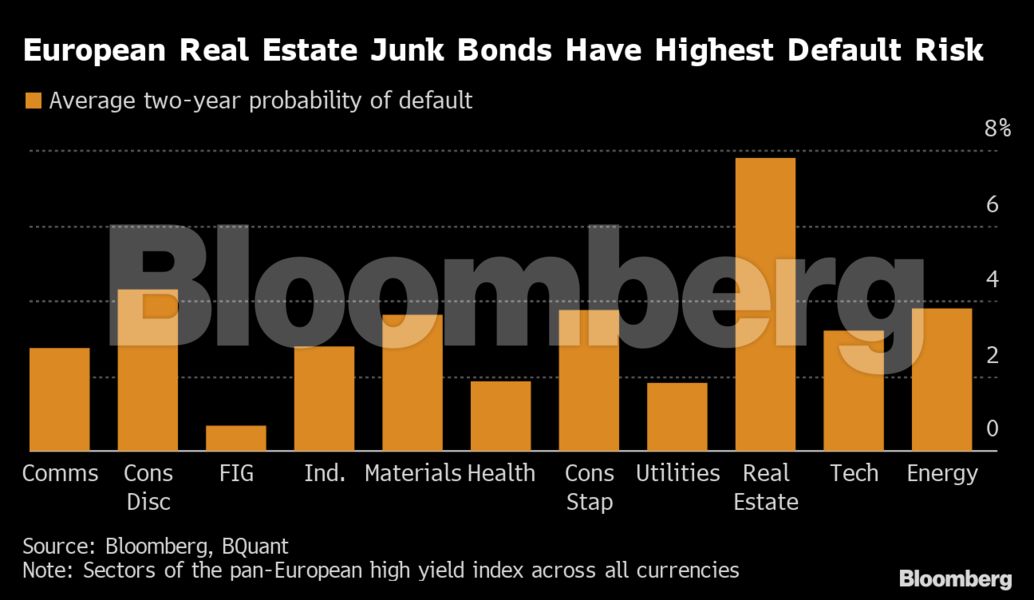(Bloomberg) -- The slump in the world’s biggest asset class has spread from the housing market to commercial real estate, threatening to unleash waves of credit turmoil across the economy.
Almost $175 billion of real estate credit is already distressed, according to data compiled by Bloomberg — about four times more than the next biggest industry. As the toll from higher interest rates and the end of easy money mounts, many real estate markets are almost frozen with some lenders telling borrowers to sell assets or risk foreclosure amid demands for additional capital from landlords.
Distress levels in European real estate are at the highest in a decade, in part because of a decline in liquidity, according to a study by law firm Weil, Gotshal & Manges. UK commercial property values fell more than 20% in the second half of 2022, MSCI Inc. data show. In the US, the drop was about 9%, according to Green Street.
The fall in transactions and development in commercial and residential real estate will inevitably impact spending in the real economy. In turn, that could pose a risk to jobs and growth.
“What we have in this downturn is a fairly unique set of economic circumstances. Interest rates are tightening instead of softening the blow for real estate and other corporates,” said Ian Guthrie, a senior managing director at the loan advisory team at Jones Lang LaSalle Inc., a real estate broker. “You have a pipeline of potentially defaulting loans” where “values are under pressure and cash flows are under pressure.”
This year, he added, “is when those problems will start to manifest themselves.” About one in 10 corporate loans in Europe is already underperforming and showing increased credit risk, according to JLL.

The abrupt halt to more than a decade of easy money has been made worse for property companies by a pandemic that has changed the way people work and live, leaving many commercial real estate owners high and dry.
The repercussions are being felt acrossthe world. A Brookfield real estate unit warned in November that it may struggle to refinance debt on two downtown Los Angeles towers and raised the prospect of foreclosures, which Barclays Plc analysts called “concerning” for the market. A missed debt payment by the developer of the Legoland Korea theme park triggered a credit crunch in the country, with the central bank forced to act to stabilize markets. Australia’s Caydon Property Group Ltd. blamed Covid lockdowns and rising interest rates when it fell into receivership.
“We expect to see some casualties” among UK developers, said Nicole Lux, who studies real estate credit at Bayes Business School. “There will be fire sales.”
Commercial property — from offices to shopping malls — is more sensitive to economic conditions than other asset classes, said Andreas Dombret, who served on the boards of Germany’s Bundesbank and the Bank for International Settlements, adding that “in the past, when the bubble did burst, very often this was related to commercial real estate.”
“But it’s ever so hard to ruin the party,” added Dombret. “This is why regulators often shy away from introducing countercyclical buffers at the right time: when there is no stress in the real estate market.”
It’s already begun rippling out to the wider economy. US homebuilding supplier Builders FirstSource has cut 2,600 jobs, while UK millennial favorite Made.com ended up in insolvency. Swedish household appliance manufacturer Electrolux AB announced plans to cut as many as 4,000 workers last year, many of them in North America.
The signs of a downturn are mounting in the US. But despite a dip, commercial property values “are still moderately overpriced,” said Michael Knott, head of US REIT Research at Green Street, who expects another 5% to 10% decline this year. “Appraisers are behind the curve, transaction activity has slowed down considerably.”
Several US banks predict that credit losses will grow this year. In its fourth-quarter results, Bank of America Corp. flagged an additional $1 billion of office property loans with an elevated risk of default or missed payments, while Wells Fargo & Co. expects more stress to emerge in that market as demand weakens.
The turnaround has been so swift that some private credit lenders are already struggling with liquidity, said Tom Capasse, chief executive officer at real estate financing firm Ready Capital Corp., adding that the company is looking to “buy other people’s problems,” including construction loans.
“We’re in an orderly bear market” where “banks are pruning their portfolios,” he added.
‘Two Fires Raging at Once’
The stress points in commercial property are expected to be at either end of the market: older buildings where the occupier has moved out, and developments that have yet to reach completion. Nowhere has experienced that latter phenomenon more than China. In September, construction of an estimated 2 million homes had been halted as the property market slowed.
Delays in projects in China are being keenly watched by everyone from economists to distressed debt investors amid plunging sales across the nation and sporadic mortgage boycotts. It followed a government crackdown on the industry in 2020 that sought to cut developers’ leverage, reduce home prices and lower the risk to the financial sector.
Beijing has changed its approach in recent weeks and may allow property firms to add more debt as part of a softening of the authorities’ stance. It comes just months after the International Monetary Fund warned of the risk of more defaults among China’s property developers — starved of liquidity — as they struggle to finish projects under construction.
In an interview with Bloomberg this week, Harvard University Professor Kenneth Rogoff said “there’s not a quick fix” for the overdevelopment of commercial real estate in parts of China.
China Evergrande Group, which defaulted on its debt a year ago, shows the turmoil. One of its Hong Kong projects was sold by receivers after the downturn, with the developer projecting a loss of about $770 million on the deal. The company proposed a restructuring plan this week after missing several earlier self-imposed deadlines.
The country’s property developers have also had problems abroad. The first phase of the Royal Albert Dock project near London’s City Airport — once billed as a new business district that could rival Canary Wharf — was put up for sale last year after the Chinese developer that owned the site collapsed.
“The end of Covid Zero in China has left the economy especially vulnerable,” wrote David Qu at Bloomberg Economics. “That may have played a role in the timing of what is essentially a rescue line for developers. Government is probably loath to have two fires raging at once.”
Read more: How China’s Property Developers Got Into Such a Mess
Rogoff, and fellow economist Yuanchen Yang, calculated in 2020 that China’s real estate industry contributed about 29% of the country’s GDP. That’s comparable with Ireland before the last financial collapse, they wrote.
Ireland became the poster child of that crisis, falling into a years-long slump after the market crashed. Since then, home values in Dublin have recovered but private credit funds are preparing to put some land plots into receivership, according to people with knowledge of the matter. Some of those selling will have been forced to do so by their lenders, the people said.
After many needed bailouts during the financial crisis, lenders in Europe have been more cautious in the current cycle, loaning at lower multiples of debt than in the run up to 2008, said Peter Cosmetatos, CEO at the Commercial Real Estate Finance Council Europe, a trade group for lenders.
“There is undoubtedly a lot of distress and pain to come in the real estate market,” but it will be felt more by borrowers because lenders have a large cushion before they take losses, he said. “It’s a healthy crisis in the sense that it is not either coming from or horribly infecting the financial sector.”
Distressed Assets
It was the lure of cheap debt that led European landlords to load up on credit after the financial crisis, snapping up portfolios where the borrowing cost was lower than the yield. That’s left real estate as the weakest link in the European junk market, with a default probability over the next two years of almost 8%, according to Bloomberg analysis. Regulators have already warned that lower demand for office space since the pandemic, the higher cost of materials from supply chain delays and rising borrowing costs will make some projects in Europe unviable.
And with fewer buyers in the market, many European landlords will have to mark down values, according to two investment bankers who asked not to be identified. In Sweden, where house prices are in freefall, Samhallsbyggnadsbolaget i Norden AB has already agreed to sell property worth almost $1 billion to pay off debt, a sign that landlords in the country are moving to reduce leverage.

A similar situation is playing out in the US where borrowers are demanding bigger discounts than many sellers are prepared to offer.
“The leveraged buyer has been pretty much handcuffed and removed from the bidding tent because of what’s happened with interest rates and debt financing,” said Knott at Green Street, referencing the broader market. “Sellers have not fully reset their expectations to better align with where buyers are, so we do see a large bid-ask spread.”
This standoff over valuations has contributed to banks and other credit providers being more conservative around new lending. When landlords come to refinance, they may have to inject as much as 25% of the original purchase price to satisfy the metrics that banks lend against, according to JLL’s Guthrie.
This pressure on the ratios that measure borrowers’ ability to cover interest payments is “a dynamic which has not been felt since the days of the financial crisis,” said Will Nicoll, chief investment officer of private and alternative assets at M&G Plc, who oversees about £77 billion in assets.
Adam Tooze, a professor at New York’s Colombia University who has written about the 2008 crash, sees reasons to worry again. “Property is a major recession variable,” he said. “It's the biggest asset class and is directly linked to household budgets, which means it carries consequences for consumption.”
“It’s a large recession risk,” he said.
--With assistance from Simon Kennedy, Zoe Schneeweiss, Lisa Abramowicz and Tasos Vossos.
To contact the author of this story:
Neil Callanan in London at [email protected]
© 2023 Bloomberg L.P.





